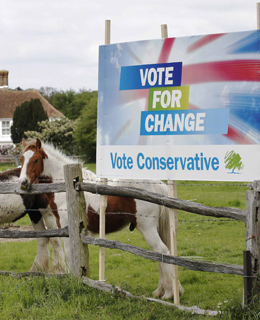
Horses in a field next to a Conservative Party campaign poster at Pirbright near Guildford
This campaign has been notable for the Conservatives' failure to maintain their healthy advantage in the opinion polls — just a few months ago, some gave David Cameron's party a lead of over 20% — and for the stellar performance of Liberal Democrat leader Nick Clegg in Britain's first ever TV debates. Throw in Prime Minister Gordon Brown "fighting for his life" and it's clear that many of the 650 parliamentary seats in play will go down to the wire as voters try to decide among their three options: stick with Labour in the midst of continuing economic turmoil; turn to the untested Clegg and his Lib Dems; or hand the keys of No. 10 Downing Street over to Cameron and the Conservatives. "If the Tories (nickname for the Conservatives) win a seat like Kingswood, then that's a 6.5% swing and that's the kind of swing they require, certainly to be around the 326 mark," says John Curtice, Professor of Politics at the University of Strathclyde in Scotland, who specializes in electoral behavior. "But what's also crucial is constituencies like Guildford. If the Tories lose seats like that to the Liberal Democrats, they're unlikely to get a majority." A seat such as Guildford, situated about 20 miles outside of London, had been in the hands of the Conservatives between 1906 and 2001, before they lost it to the Liberal Democrats. The Tories regained the seat in 2005 but it has a miniscule majority of just 347 votes.
Both Kingswood, near Bristol in southwest England, and Guildford are also affected by boundary changes at this election, which may prove to play a big part in the end result. The Boundary Commission — which is legally required to review all the constituencies every 8 to 12 years to ensure the size and composition are as fair as possible — has redrawn many of the borders this year, meaning that previous party strongholds have turned into sites for close election races. Had those redrawn boundaries been in effect at the last election in 2005, it's fair to conclude that the current incumbent in certain seats would not now be in power. For example, the Conservatives would currently hold 10 extra seats which were actually won by the Labour Party. This time around, the Conservatives will be hoping to take them for real.